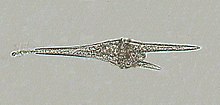囊泡蟲
| 囊泡蟲類 化石時期:
| |
|---|---|

| |
| 叉角藻 | |
| 科學分類 | |
| 演化支: | SAR 超類群 SAR |
| 演化支: | 囊泡蟲類 Alveolata |
| 門 | |
囊泡蟲總門(學名:Alveolata)[2]是一大類原生生物.
門
[編輯]囊泡蟲類可分為4個門, 在形態上具有非常大的多樣性,但根據細胞內的超微結構與基因具有密切親緣關係:
- 頂復門(Apicomplexa) - 營寄生的原生生物,缺少軸絲運動結構,但是配子例外;
- 色蟲門(Chromerida) - 一種具有光合自養的海生原生動物,是頂複門與藻類的進化過渡的中間物種;
- 纖毛蟲門(Ciliate) - 非常常見的原生動物,具有成排的纖毛
- 雙鞭毛蟲門(Dinoflagellate) - 大都是海生鞭毛蟲,往往有葉綠體
帕金蟲屬(Perkinsus)可能屬於另一個進化分枝 - 帕金蟲門(Perkinsozoa) - 基於許多分子生物學證據.[3]
特徵
[編輯]囊泡蟲最著名的公共特徵是存在皮層內生膜囊(cortical alveoli), 扁平的囊泡摺疊為連續層支撐着膜,通常形成靈活的薄皮。雙鞭毛蟲通常形成硬殼。 囊泡蟲具有帶管狀嵴的線粒體。鞭毛或纖毛有不同結構.
這類原生生物的祖先顯然是營光合作用的.[4]
幾乎所有的纖毛蟲與頂復門寄生蟲的線粒體基因組是線狀的.[5]巴貝斯原蟲(Babesia microti)的線粒體基因是環形的.[6]這個物種因而被認為不屬於巴貝斯蟲屬(Babesia)或泰勒蟲屬(Theileria),應該為它創建一個新的屬。
分類
[編輯]頂復門與雙鞭毛蟲門具有很近的親緣關係,被合稱為粘孢子總門,而纖毛蟲門則比較疏遠。頂復門與雙鞭毛蟲門都有色素體,在細胞頂部大都有一束或圓錐形微管. 對於頂復門生物,這形成了頂復器用於進入宿主細胞。某些無色的雙鞭毛蟲這形成了口器用於攝入被掠食的微生物。其它囊泡蟲類的生物與這兩類具有不同遠近的親緣關係,大部分鞭毛蟲有類似的頂器結構。這包括自由生活的Oxyrrhis與Colponema, 營寄生的Perkinsus, Parvilucifera, Rastrimonas與ellobiopsid. 2001年, 對海洋微微型浮游生物樣本的rRNA研究表明,存在兩個新的囊泡蟲進化世系,稱作group I與II.[7][8]Group I沒有近緣親屬,而group II與雙鞭毛蟲門共甲藻目(Syndiniales)的寄生生物Amoebophrya親緣很近.
在1980年代,提出了這幾大類微生物可能屬於一個進化分枝。1990年代通過基因研究證實了這一想法,特別是Gajadhar等人的研究工作.[9]湯瑪斯·卡弗利爾-史密斯, 於1991年正式命名了囊泡蟲總門(Alveolata),[10]在當時還認為這可能是一個並系群, 實際上後來證實是單系群.
某些研究認為最著名的海洋無脊椎動物的寄生蟲haplosporid應該屬於囊泡蟲總目,但缺少腔區(alveoli),因此現在被分類在有孔蟲界的絲足蟲類.
發展
[編輯]囊泡蟲的色素體的發展還不確定. 卡弗利爾-史密斯建議囊泡蟲的祖先是一種有葉綠體的,並發展成了色藻界 (囊泡藻界假說). 但是,色素體只出現在相對衍生的(而不是比較古老的)群體, 其它人的觀點是囊泡蟲最初缺少色素體,可能是雙鞭毛蟲與頂復門生物分別獨立獲取色素體。
也很可能是囊泡蟲總門與不等鞭毛總門的色素體這個細胞器有一個共同起源,是從紅藻那裡獲得了色素體.[11]
進化
[編輯]囊泡蟲的共同起源可能是一種吸食(myzocytotic)被掠食者的細胞,有兩條鞭毛, 微孔, 刺絲胞(trichocyst), 棒狀體(Rhoptry), microneme, polar ring與一個錐形頂部開口的頂器.[12]這個祖先可能擁有色素體,但還不清楚是否具有光合作用的能力。還不清楚現存的perkinsids與colpodellids是否還有這個細胞器.
參考文獻
[編輯]- ^ Li, C.-W.; et al.. Ciliated protozoans from the Precambrian Doushantuo Formation, Wengan, South China. Geological Society, London, Special Publications. 2007, 286: 151–156. doi:10.1144/SP286.11.
- ^ alveolate. Memidex (WordNet) Dictionary/Thesaurus. [2011-01-26]. (原始內容存檔於2016-04-11).
- ^ Zhang H, Campbell DA, Sturm NR, Dungan CF, Lin S (2011) Spliced leader RNAs, mitochondrial gene frameshifts and multi-protein phylogeny expand support for the genus Perkinsus as a unique group of Alveolates. PLoS One. 2011;6(5):e19933
- ^ Reyes-Prieto A, Moustafa A, Bhattacharya D. (2008) Multiple genes of apparent algal origin suggest ciliates may once have been photosynthetic. 18 (13):956-962
- ^ Barth D, Berendonk TU (2011) 纖毛蟲門的草履蟲的線粒體基因序列揭示了草履蟲屬的核苷組成與密碼子使用的平移. BMC Genomics. 12:272
- ^ Cornillot E, Hadj-Kaddour K, Dassouli A, Noel B, Ranwez V, Vacherie B, Augagneur Y, Brès V, Duclos A, Randazzo S, Carcy B, Debierre-Grockiego F, Delbecq S, Moubri-Ménage K, Shams-Eldin H, Usmani-Brown S, Bringaud F, Wincker P, Vivarès CP, Schwarz RT, Schetters TP, Krause PJ, Gorenflot A, Berry V, Barbe V, Ben Mamoun C (2012) Sequencing of the smallest Apicomplexan genome from the human pathogen Babesia microti{dagger} Nucleic Acids Res
- ^ López-García, P. et al. (2001). Unexpected diversity of small eukaryotes in deep-sea Antarctic plankton. Nature 409: 603-7.
- ^ Moon-van der Staay, S. Y. et al. (2001). Oceanic 18S rDNA sequences from picoplankton reveal unsuspected eukaryotic diversity. Nature 409: 607-10.
- ^ Gajadhar, A. A.; et al. Ribosomal RNA sequences of Sarcocystis muris, Theilera annulata, and Crypthecodinium cohnii reveal evolutionary relationships among apicomplexans, dinoflagellates, and ciliates. Molecular and Biochemical Parasitology. 1991, 45: 147–153. doi:10.1016/0166-6851(91)90036-6.
- ^ Cavalier-Smith, T. (1991). Cell diversification in heterotrophic flagellates. In The Biology of Free-living Heterotrophic Flagellates, ed. D.J. Patterson & J. Larsen. pp. 113-131. Oxford University Press.
- ^ Janouskovec J, Horák A, Oborník M, Lukes J, Keeling PJ (2010) A common red algal origin of the apicomplexan, dinoflagellate, and heterokont plastids. Proc Natl Acad Sci USA 107(24):10949-10954
- ^ Kuvardina ON, Leander BS, Aleshin VV, Myl'nikov AP, Keeling PJ, Simdyanov TG (2002) The phylogeny of colpodellids (Alveolata) using small subunit rRNA gene sequences suggests they are the free living sister group to apicomplexans. J Eukaryot Microbiol 49(6):498-504
外部連結
[編輯]
| ||||||||||||||||||||||||||||||||||||||||||||||||||||||||||||||||||||||||||||||||||
|
